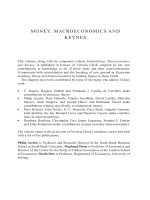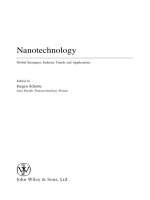AD HOC NETWORKS Technologies and Protocols phần 1 potx
Bạn đang xem bản rút gọn của tài liệu. Xem và tải ngay bản đầy đủ của tài liệu tại đây (392.35 KB, 30 trang )
AD HOC NETWORKS
Technologies and Protocols
This page intentionally left blank
AD HOC NETWORKS
Technologies and Protocols
Edited by
PRASANT MOHAPATRA
University of California‚ Davis
SRIKANTH V. KRISHNAMURTHY
University of California‚ Riverside
Springer
eBook ISBN: 0-387-22690-7
Print ISBN: 0-387-22689-3
Print ©2005 Springer Science + Business Media, Inc.
All rights reserved
No part of this eBook may be reproduced or transmitted in any form or by any means, electronic,
mechanical, recording, or otherwise, without written consent from the Publisher
Created in the United States of America
Boston
©2005 Springer Science + Business Media, Inc.
Visit Springer's eBookstore at:
and the Springer Global Website Online at:
Contents
List of Figures
List of Tables
Contributing Authors
Preface
Acknowledgments
xi
xvii
xix
xxi
xxiii
1
Ad Hoc Networks
Mario Gerla
1
1.1. Introduction and Definitions
1.1.1
1.1.2
1.1.3
Wireless Evolution
Ad hoc Networks Characteristics
Wireless Network Taxonomy
1.2. Ad Hoc Network Applications
1
3
4
5
6
7
1.2.1
1.2.2
The Battlefield
The Urban and Campus Grids: a case for opportunistic ad
hoc networking
1.3.
Design Challenges
10
12
12
13
15
17
21
22
1.3.1
1.3.2
Cross Layer Interaction
Mobility and Scaling
1.4.
1.5.
1.6.
Evaluating Ad Hoc Network Protocols - the Case for a Testbed
Overview of the Chapters in this Book
Conclusions
References
2
Collision Avoidance Procotols
23
J. J. Garcia-Luna-Aceves and Yu Wang
2.1. Performance of collision avoidance protocols
2.1.1
2.1.2
2.1.3
Approximate Analysis
Numerical Results
Simulation Results
25
26
35
39
44
46
48
54
58
2.2.
2.3.
Framework and Mechanisms for Fair Access in IEEE 802.11
2.2.1
2.2.2
2.2.3
The Fairness Framework
Topology-Aware Fair Access
Simulation Results
Conclusion
vi
AD HOC NETWORKS
References
60
3
Routing in Mobile Ad Hoc Networks
Mahesh K. Marina and Samir R. Das
63
3.1.
3.2.
Introduction
Flooding
63
65
66
68
69
70
71
72
72
75
77
77
79
80
81
84
84
86
91
91
94
94
95
96
97
99
103
105
106
108
108
109
112
112
113
114
114
114
115
117
118
3.2.1
Efficient Flooding Techniques
3.3. Proactive Routing
3.3.1
3.3.2
3.3.3
Distance Vector Protocols
Link State Protocols
Performance of Proactive Protocols
3.4. On-demand Routing
3.4.1
3.4.2
3.4.3
Protocols for On-Demand Routing
Optimizations for On-demand Routing
Performance of On-Demand Routing
3.5. Proactive Versus On-demand Debate
3.5.1 Hybrid Approaches
3.6.
Location-based Routing
3.6.1
3.6.2
Location-based Routing Protocols
Location Service Protocols
3.7.
Concluding Remarks
References
4
Multicasting in Ad Hoc Networks
Prasant Mohapatra‚ Jian Li‚ and Chao Gui
4.1.
4.2.
Introduction
Classifications of Protocols
4.2.1
4.2.2
Dealing with Group Dynamics
Dealing with Network Dynamics
4.3. Multicasting Protocols
4.3.1
4.3.2
4.3.3
4.3.4
4.3.5
4.3.6
4.3.7
Multicast operations of AODV (MAODV)
Reliance on More Nodes
Reliance on Backbone Structure
Stateless Multicasting
Overlay Multicasting
Location Aided Multicasting
Gossip-Based Multicasting
4.4.
4.5.
Broadcasting
Protocol Comparisons
4.5.1
4.5.2
4.5.3
Network Size
Network Mobility
Multicast Group Size
4.6. Overarching Issues
4.6.1
4.6.2
4.6.3
4.6.4
Energy Efficiency
Reliable Multicasting
QoS-AwareMulticasting
Secure Multicasting
Contents
vii
4.7. Conclusions and Future Directions
References
119
119
5
Transport Layer Protocols in Ad Hoc Networks
Karthikeyan Sundaresan‚ Seung-Jong Park‚ Raghupathy Sivakumar
123
5.1.
5.2.
Introduction
TCP and Ad-hoc Networks
TCP Background
Window-based Transmissions
Slow Start
Loss-based Congestion Indication
Linear Increase Multiplicative Decrease
Dependence on ACKs and Retransmission Timeouts
Absolute Impact of Losses
5.3.
5.4.
5.5.
5.6.
5.7.
Transport Layer for Ad-hoc Networks: Overview
Modified TCP
TCP-aware Cross-layered Solutions
Ad-hoc Transport Protocol
Summary
References
6
Energy Conservation
Robin Kravets and Cigdem Sengul
6.1.
Energy Consumption in Ad Hoc Networks
6.1.1
6.1.2
6.1.3
6.1.4
Point-to-Point Communication
End-to-End Communication
Idle Devices
Energy Conservation Approaches
6.2.
Communication-Time Energy Conservation
6.2.1
6.2.2
6.2.3
Power Control
Topology Control
Energy-Aware Routing
6.3.
Idle-time Energy Conservation
6.3.1
6.3.2
Communication Device Suspension
Power Management
6.4.
Conclusion
References
7
Use of Smart Antennas in Ad Hoc Networks
Prashant Krishnamurthy and Srikanth Krishnamurthy
7.1.
7.2.
Introduction
Smart Antenna Basics and Models
7.2.1
7.2.2
7.2.3
Antennas in Brief
Important Antenna Parameters
Directional Antenna Models
7.3.
Medium Access Control with Directional Antennas
7.3.1
The IEEE 802.11 MAC Protocol in Brief
124
125
126
127
129
131
132
132
134
135
137
140
146
150
151
153
155
155
157
157
158
158
158
161
172
176
176
186
190
190
197
197
198
199
200
201
201
202
5.2.1
5.2.2
5.2.3
5.2.4
5.2.5
5.2.6
5.2.7
viii
AD HOC NETWORKS
7.3.2
Directional Transmissions and the IEEE 802.11 MAC proto-
col
Directional Medium Access Control with Omni-Directional
Receptions
Adding directional receptions: Directional Virtual Carrier
Sensing
The impact of increased directional range
The Multi-hop RTS MAC Protocol (MMAC)
Dealing with Deafness: The Circular RTS message
Other Collision Avoidance MAC Protocols
Scheduled Medium Access Control
7.3.3
7.3.4
7.3.5
7.3.6
7.3.7
7.3.8
7.3.9
7.4.
Routing with Directional Antennas
7.4.1
7.4.2
7.4.3
7.4.4
On Demand Routing Using Directional Antennas
The Impact of Directional Range on Routing
A Joint MAC/Routing Approach
Remarks
7.5. Broadcast with Directional Antennas
7.5.1
7.5.2
Performance Issues in Broadcasting
Broadcast schemes with directional antennas
7.6. Summary
References
8
QoS Issues in Ad-hoc Networks
Prasun Sinha
8.1.
8.2.
8.3.
Introduction
Definition of QoS
Physical Layer
8.3.1
8.3.2
8.3.3
Auto Rate Fallback (ARF)
Receiver-Based Auto Rate (RBAR)
Opportunistic Auto Rate (OAR)
8.4. Medium Access Layer
8.4.1
8.4.2
8.4.3
8.4.4
802.11 Distributed Coordination Function (DCF)
802.11 Point Coordination Function (PCF)
The QoS Extension: 802.11e
QoS Support using DCF based Service Differentiation
8.5. QoS Routing
8.5.1
8.5.2
Core Extraction based Distributed Ad-hoc Routing (CEDAR)
Ticket based routing
8.6.
8.7.
QoS at other Networking Layers
Inter-Layer Design Approaches
8.7.1
8.7.2
INSIGNIA
Cross-Layer Design for Data Accessibility
8.8.
Conclusion
References
9
Security in Mobile Ad-Hoc Networks
Yongguang Zhang‚ Wenke Lee
9.1.
Vulnerabilities of Mobile Ad Hoc Networks
203
204
206
208
210
213
214
215
217
217
218
221
222
222
223
224
226
226
229
229
232
232
233
233
234
234
234
236
236
238
239
240
241
242
242
243
243
244
246
249
249
Contents
ix
9.2.
9.3.
Potential Attacks
Attack Prevention Techniques
9.3.1
9.3.2
9.3.3
Key and Trust Management: Preventing External Attacks
Secure Routing Protocols: Preventing Internal Attacks
Limitations of Prevention Techniques
9.4. Intrusion Detection Techniques
9.4.1
9.4.2
9.4.3
Architecture Overview
A Learning-Based Approach
Case Study: Anomaly Detection for Ad-Hoc Routing Proto-
cols
9.5.
Conclusion
References
Index
251
253
253
254
255
256
256
259
261
264
265
269
This page intentionally left blank
List of Figures
1.1
Internet in the sky architecture designed as part of the
ONR supported Minuteman project at UCLA.
1.2
1.3
2.1
2.2
2.3
2.4
2.5
2.6
2.7
2.8
2.9
2.10
2.11
2.12
2.13
2.14
3.1
3.2
3.3
An example opportunistic ad hoc network.
An example of LANMAR implementation.
Markov chain model for the channel around a node
Markov chain model for a node
Illustration of “hidden” area
influence
Throughput comparison
Network Model Illustration
Example of collisions with data packets in the IEEE
802.11 MAC Protocol
Performance comparison of IEEE 802.11 with analytical results
Performance comparison of IEEE 802.11 with adjusted
analytical results
A simple network: node graph and flow contention graph
Network configurations with two competing flows
The adaptive backoff algorithm
The criteria to choose sender-initiated or receiver-initiated
handshake
Special tag processing for two-way flows
Multipoint Relay concept. Two dotted circles around the
source S represent its logical 1-hop and 2-hop neighbor-
hood respectively.
Comparison of search regions using expanding ring search
and query localization. Dotted circles in each figure in-
dicate the search regions.
Restricted directional flooding in LAR and DREAM.
8
11
14
28
31
32
36
37
39
40
42
45
46
47
51
54
55
68
76
82
xii
List of Figure
3.4
Illustration of greedy forwarding failure and perimeter
routing in GPSR. In this figure‚ S is the source and D is
the destination. By greedy forwarding‚ S sends the packet
to node X. But all neighbors of X are farther to D than
itself‚ so greedy forwarding fails at X. X then switches to
perimeter mode and routes the packet along the perimeter
until it reaches Y (closer to D than itself). From Y‚ greedy
forwarding is used again until the packet reaches D. For
simplicity‚ in this example we have assumed that actual
network graph is planar.
4.1
4.2
4.3
A mobile ad hoc network.
Multicast join operation of MAODV.
Traffic flow from h. (a) In a CAMP mesh. (b) In the
equivalent shared tree.
4.4
4.5
4.6
4.7
4.8
4.9
The forwarding group concept.
Format of JOIN Query packet.
Format of JOIN Reply packet.
MCEDAR join procedure.
Concept of virtual topology for overlay multicast.
An example of area-based method: source node A sends
a broadcast packet‚ and intermediate node B‚ based on its
calculation of additional coverage area (shadowed in the
figure)‚ decides whether to rebroadcast the packet. Note
that the additional coverage area of node B is a function
of transmission radius R and nodal distance d. When d
= R‚ the maximum additional coverage area is reached‚
which is about
5.1
5.2
5.3
5.4
5.5
5.6
5.7
5.8
5.9
6.1
Number of route errors
Round-trip Time and Timeouts (1 Flow)
Slow-start and Loss-based Congestion Detection
Route Errors and Impact of Losses
Classification of Approaches
TCP-ELFN (1 Flow)
Atra (1 Flow)
ATP(1 Flow)
Key Elements in Approaches
6.2
Node power level is less than node and communi-
cation is not possible.
Node CTS does not silence node and so node k can
interfere with node since node power level is higher.
83
92
98
100
100
101
102
104
107
111
126
128
130
133
136
139
145
149
150
160
160
List of Figures
xiii
6.3
COMPOW computes a common power level of 100mW
for the network‚ which shows that a common power level
is not appropriate for non-homogeneous networks. With
CLUSTERPOW‚ the network has three clusters corre-
sponding to 1mW‚ 10mW and 100mW. The 100 mW
cluster is the whole network. A 10mW-100mW-10mW-
1mW route is used for node
to reach node
6.4
Enclosure of node Node computes the relay regions
of nodes and Relay Regions 1‚ 2 and 3 (cor-
responding to nodes and respectively) specify the
enclosure of node Node maintains links only to nodes
and Nodes and are not contained in node
enclosure‚ and therefore‚ are not its neighbors.
6.5
Neighbor discovery in the cone-based algorithm‚
Node adjusts its power level to to reach all neigh-
bors in all cones. Although‚ cone III (due to node being
outside the range )‚ node does not unneces-
sarily adjust to
6.6
An example of unidirectional links using LMST. There
are 6 nodes‚ The visible Neigh-
borhood of node is and the neighbors of
node are nodes and The visible Neighborhood of
node is and only node is its
neighbor. Therefore‚ but
6.7
6.8
6.9
Example topologies created by the LMST algorithm
IEEE 802.11 Power-save Mode
Mis-matched Beacon Intervals. Node 2 can never hear
the ATIM from node 1.
6.10 Alternating odd and even cycles ensure that all nodes can
hear each other’s notification messages.
6.11
6.12
Using two notification windows guarantees overlap.
Nodes remain awake once every T intervals
(
T = 4).
However‚ communication is delayed up to
T
times the
length of the beacon interval
6.13 Nodes remain awake once every intervals.
Nodes each choose one row and one column (i.e.‚ node
chooses row and column and node chooses row
and column
6.14
Node chooses row 0 and column 1 and node chooses
row 2 and column 2. Both stay awake during intervals 2
and 9
166
168
170
170
178
180
181
181
183
183
183
163
xiv
List of Figure
6.15
Slot allocations determine when each node remains awake.
This figure shows an example slot allocation that guar-
antees at least one overlapping slot between any two nodes.
184
6.16 Nodes with offset slots are guaranteed to hear each other’s
beacon messages at least once per cycle
184
6.17
Example Connected Dominating Set. The black nodes
form the CDS. Nodes 1-5 are all only one hop away from
a node in the CDS.
188
6.18 GAF’s virtual grid. One node in each grid location re-
mains awake to create a connected dominating set.
189
7.1
Footprint of (a) An Omni-directional Antenna and (b) A
Directional Antenna
200
7.2
7.3
The Cone and Sphere Radiation Pattern
The effect of omni-directional / directional transmissions
of control messages with the 802.11 MAC Protocol
202
204
7.4
7.5
7.6
7.7
7.8
7.9
A Scenario to Understand the Schemes Proposed in D-MAC
A Scenario to Understand the Problems with DMAC
The MMAC Protocol
The Circular RTS message
The Multi-Beam Antenna Array
Impact of omni-directional route requests
206
209
211
214
215
219
221
222
231
231
235
236
237
7.10
7.11
The Selective Forwarding Optimization
Route Coupling
8.1
8.2
8.3
8.4
8.5
8.6
Wireless LAN
Ad-hoc Network
IEEE 802.1l DCF
Packet formats for basic 802.11
Point Coordination Function (PCF)
Example of a 802.11 super-frame. It relies on TXOPs
(Transmission opportunities). Polled TXOP may be lo-
cated in Contention Period or Contention-Free Period.
8.7
8.8
8.9
Multiple backoff of streams with different priorities
Service Differentiation using different DIFS values
CEDAR: Core nodes in a network
8.10
8.11
INSIGNIA QoS Framework
Cross-Layer Design for Data Accessibility
237
238
239
241
243
244
List of Figures
xv
9.1
9.2
An IDS architecture for mobile ad-hoc network: IDS
agents run on monitoring nodes throughout the network.
Each MANET node can be the monitoring node for itself.
Alternatively‚ a cluster of neighboring nodes can share
one monitoring node.
A conceptual model of an IDS agent
257
258
This page intentionally left blank
List of Tables
2.1
2.2
2.3
2.4
2.5
2.6
2.7
IEEE 802.11 protocol configuration parameters
Equivalent configuration parameters for analytical model
Percentage of ACK timeout in BEB scheme
Notations used in the hybrid scheme
An example of two-way flow processing
IEEE 802.11 and TAFA specific configuration parameters
Throughput comparison for the IEEE 802.11‚ the hybrid
scheme and TAFA – two CBR flows (throughput mea-
sured in kbps)
2.8
Throughput comparison for the IEEE 802.11‚ the hybrid
scheme and TAFA – two FTP flows (throughput mea-
sured in kbps)
4.1
6.1
Classification
Transmit‚ receive and sleep mode energy costs for se-
lected wireless cards.
6.2
Transmit power levels for selected wireless cards with
power control capabilities.
6.3
9.1
9.2
Transmission rates for selected wireless card types.
Feature Set I: Topology and route related features
Feature Set II: Traffic related features: dimensions and
allowable values
9.3
9.4
Detection rates of the C4.5 models‚ with false alarm rate =1%
Features in the necessary conditions of the attacks
41
41
43
53
55
56
57
58
97
155
156
156
263
263
264
264
This page intentionally left blank
Contributing Authors
Samir R. Das is an Associate Professor in the Department of Computer Science
at the Stony Brook University‚ New York. His email address is
J. J. Garcia-Luna-Aceves is the Baskin Professor of Computer Engineer-
ing at the University of California‚ Santa Cruz‚ CA. His email address is
Mario Gerla is a Professor in the Computer Science Department at the Univer-
sity of California‚ Los Angeles‚ CA. His email address is
Chao Gui is a doctoral candidate in the Department of Computer Science at the
University of California‚ Davis‚ CA. His email address is
Robin Kravets is an Assistant Professor in the Department of Computer Sci-
ence at the University of Illinois in Urbana-Champaign. Her email address is
Prashant Krishnamurthy is an Assistant Professor in the Telecommunications
Program at the University of Pittsburgh‚ PA. His email address is
Srikanth Krishnamurthy is an Assistant Professor in the Department of Com-
puter Science and Engineering at the University of California‚ Riverside‚ CA.
His email address is
Wenke Lee is an Assistant Professor in the College of Computing at the Georgia
Institute of Technology‚ GA. His email address is
xx
List of Tables
Jian Li is a doctoral candidate in the Department of Computer Science at the
University of California‚ Davis‚ CA. His email address is
Mahesh K. Marina is a doctoral candidate in the Department of Computer
Science at the Stony Brook University‚ New York. His email address is ma-
hesh @ cs. sunysb. edu.
Prasant Mohapatra is a Professor in the Department of Computer Science‚
University of California‚ Davis‚ CA. His email address is
Seung-Jong Park is a doctoral candidate in the School of Electrical and Com-
puter Engineering at the Georgia Institute of Technology‚ GA. His email address
is
Cigdem Sengul is a graduate student in the Department of Computer Science
at the University of Illinois in Urbana-Champaign. Her email address is sen-
Prasun Sinha is an Assistant Professor in the Department of Computer and
Information Science at Ohio State University‚ OH. His email address is
Raghupathy Sivakumar is an Assistant Professor in the School of Electrical
and Computer Engineering at the Georgia Institute of Technology‚ GA. His
email address is
Karthikeyan Sundaresan is a doctoral candidate in the School of Electrical
and Computer Engineering at the Georgia Institute of Technology‚ GA. His
email address is
Yu Wang is a doctoral candidate in the Department of Computer Engineer-
ing at the University of California‚ Santa Cruz‚ CA. His email address is
Yongguang Zhang is a Senior Research Scientist at the HRL Laboratories‚ CA.
His email address is
Preface
Wireless mobile networks and devices are becoming increasingly popular as
they provide users access to information and communication anytime and any-
where. Conventional wireless mobile communications are usually supported
by a wired fixed infrastructure. A mobile device would use a single-hop wire-
less radio communication to access a base-station that connects it to the wired
infrastructure. In contrast‚ ad hoc networks does not use any fixed infrastruc-
ture. The nodes in a mobile ad hoc network intercommunicate via single-hop
and multi-hop paths in a peer-to-peer fashion. Intermediate nodes between a
pair of communicating nodes act as routers. Thus the nodes operate both as
hosts as well as routers. The nodes in the ad hoc network could be potentially
mobile‚ and so the creation of routing paths is affected by the addition and
deletion of nodes. The topology of the network may change randomly‚ rapidly‚
and unexpectedly.
Ad hoc networks are useful in many application environments and do not
need any infrastructure support. Collaborative computing and communications
in smaller areas (building organizations‚ conferences‚ etc.) can be set up using
ad hoc networking technologies. Communications in battlefields and disaster
recovery areas are other examples of application environments. Similarly com-
munications using a network of sensors or using floats over water are other
applications. The increasing use of collaborative applications and wireless de-
vices may further add to the need for and the usage of ad hoc networks.
During the last few years‚ numerous papers and reports have been published
on various issues on mobile ad hoc networks. Several tutorials and survey
reports have been also published on specific aspects of the mobile ad hoc net-
works. In fact‚ conferences and symposiums that are dedicated to ad hoc net-
working have emerged. However‚ a “one-stop” resource for overviewing or
summarizing the knowledge and progress on ad hoc networking technologies
is currently unavailable. Our co-edited book is primarily motivated by these
lines of thought.
We have put together a set of interesting chapters that deal with various in-
teresting focal aspects in ad hoc networks. The first chapter is a forerunner
for things to come. It primarily motivates the need for ad hoc networks and
xxii
discusses the evolution of these networks and projects future directions and
challenges. The second chapter primarily looks at contention based medium
access control in ad hoc networks. Most of the research in ad hoc networks
assume the use of either the IEEE MAC protocol or variants thereof and this
chapter enuniciates by means of both discussion and analyses the nuances of
such MAC protocols. The third chapter provides an in-depth discussion of
routing in ad hoc networks. Next‚ we provide a discussion of multicasting in
ad hoc networks‚ the issues that arise and the technologies that have emerged.
We follow with a discussion of transport layer issues and the protocol designs
thus far in the fifth chapter. Since ad hoc networks consist of wireless bat-
tery operated devices managing energy / power consumption is of paramount
importance. The sixth chapter deals exclusively with issues related to power
management. Lately‚ in order to increase the achievable capacity in ad hoc
networks there has been a lot of interest in the use of directional antennas and
we deliberate various protocols that have emerged for use with such antennas in
Chapter seven. Various issues related to the provision of quality of service and
mechanisms for dealing with these issues are presented in the eighth chapter.
Finally‚ we have a chapter on security‚ a vital component that will determine
the successful deployment and emergence of ad hoc networks.
PRASANT M
OHAPATRA AND
S
RIKANTH
K
RISHNAMURTHY
xxiii
Acknowledgments
We wish to express our heartfelt thanks to all of the authors for helping us
with this effort and for participating in this effort. We also wish to thank Chao
Gui for helping us with compiling and formating of the chapters. Our thanks
to Alex Greene from Kluwer for his patience while we were in the process of
completing the book and for his support throughout. Thanks are also due to our
families for their support and patience during the entire process.
This page intentionally left blank









